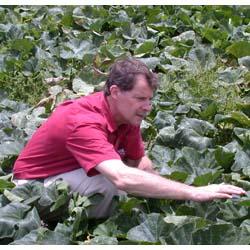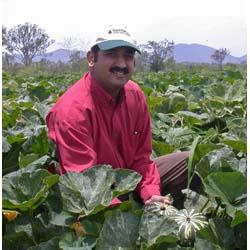Tiny fly may become big problem for Aussie farmers
Published on 10 August, 2006
A Central Queensland University researcher believes the Australian horticulture industry is at risk of facing an ecological disaster costing up to $1.5 billion if the tiny Silverleaf Whitefly has its way.
PhD student Sohail Qureshi is undertaking a study in Central Queensland looking at the population of the Whitefly, the intensity and timing of damage to horticultural crops, and the choice crops for the insect. He is also looking specifically at the damage to crops like pumpkin, bitter melon, cucumber and zucchini.
 Mr Qureshi has conducted year round sampling in the region since 2004, both in conventional and organic farms, in the hope of finding a solution to this potentially devastating problem.
Mr Qureshi has conducted year round sampling in the region since 2004, both in conventional and organic farms, in the hope of finding a solution to this potentially devastating problem.
The Silverleaf Whitefly adult in only about a millimetre in length, and has solid white wings and a pale-yellow body. The insect feeds on the lower surfaces of leaves by sucking sap with their piecing-sucking mouthparts.
Mr Qureshi said the pest has an extremely huge appetite for over 540 species of plants, many of which are of economic importance to our agricultural industry.
“The Whitefly causes damage through direct feeding, which may induce irreversible physiological disorders and yield decline,” he explained. “They also excrete honeydew and can transmit viruses”.
“Colonies develop on the underside of leaves on most susceptible species, a factor which makes chemical control difficult”.
Quite a resilient insect, the Whitefly survives in habitats ranging from temperate through to tropical, it undergoes 11 to 15 generations in a year and can produce as many as 300 eggs per adult.
Squash silverleaf is one of the major physiological disorders caused by feeding of the Whitefly. “We believe the immature Whitefly nymphs, and not the winged adults, are responsible for these symptoms".
The honeydew left on plants encourages the growth of sooty mould on the leaves, thereby inhibiting photosynthesis.
This could be devastating for the Central Highland’s cotton farms.
 “In cotton crops, the honeydew can also foul the lint making mechanism, which makes it difficult to process and renders the cotton unsaleable”.
“In cotton crops, the honeydew can also foul the lint making mechanism, which makes it difficult to process and renders the cotton unsaleable”.
“In 1991, this pest caused a loss of $US 500 million in the USA, the loss of nearly 10,000 jobs and product shortage and price increases”.
It has also destroyed the cotton industry of Pakistan and caused a loss of US$ 5 billion during 1990s.
Mr Qureshi hopes to identify the fly’s natural enemies (predators); evaluate the importance of physical barriers in controlling the fly population in organic farming; and evaluate the effectiveness of the insect growth regulators buprofezin and pyriproxyfen; and also the timing and extent of damage along with the movement pattern and host preference of whitefly.
Above: Sohail Qureshi checks the condition of pumpkin plants at a farm near Rockhampton, on the eastern side of the Fitzroy River.
Left: CQU's Professor David Midmore checking out the pumpkin patch.

